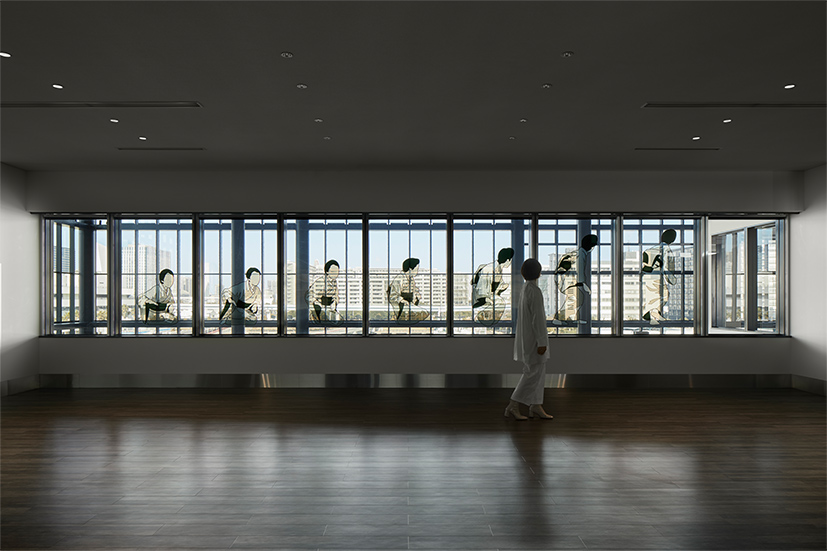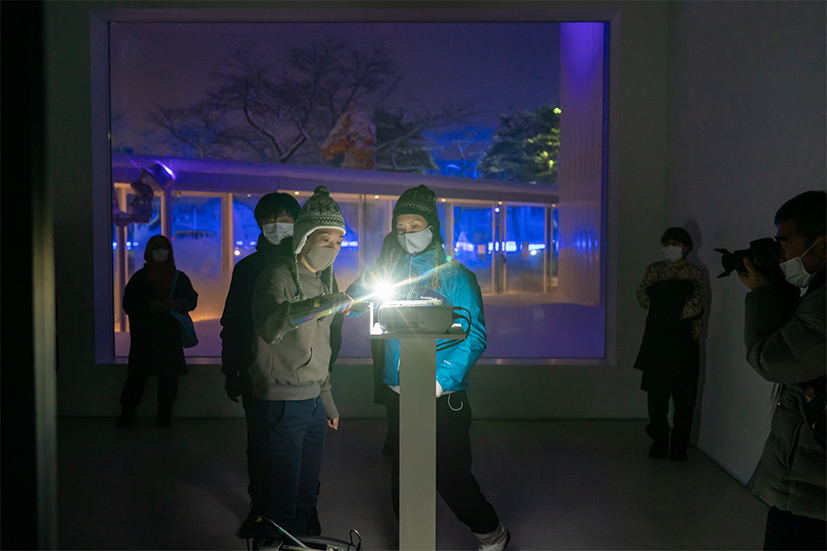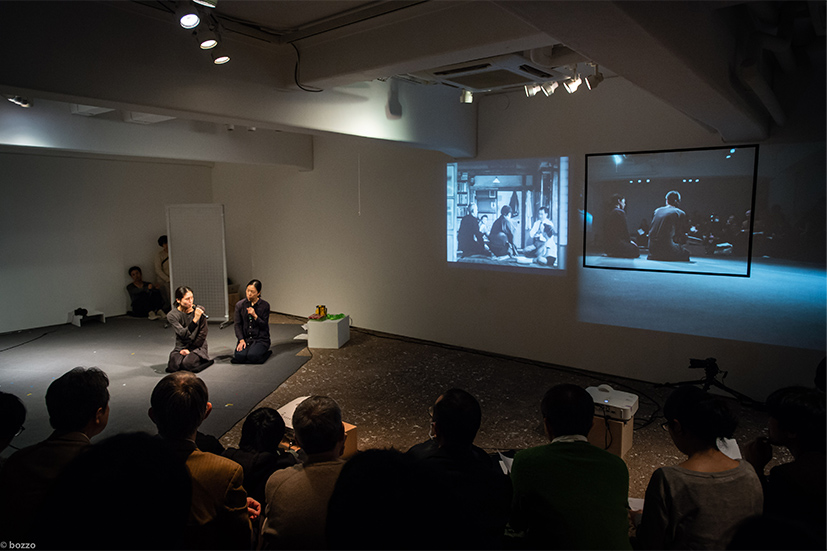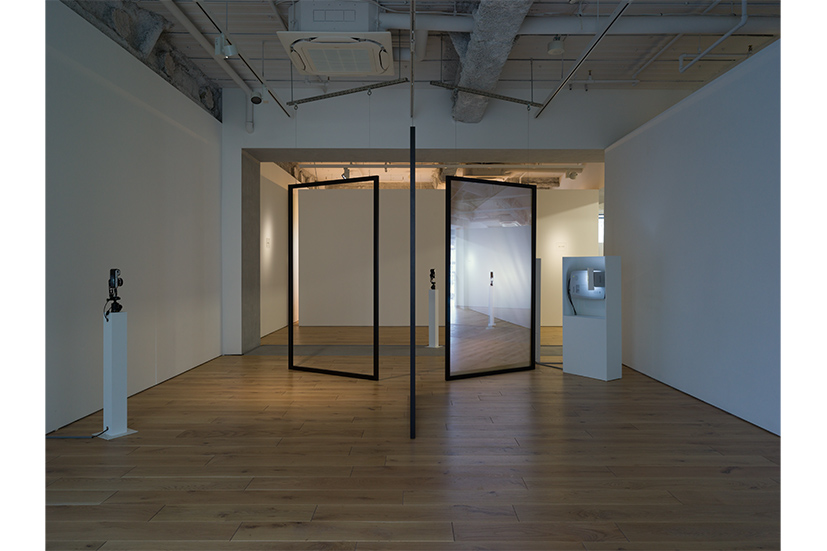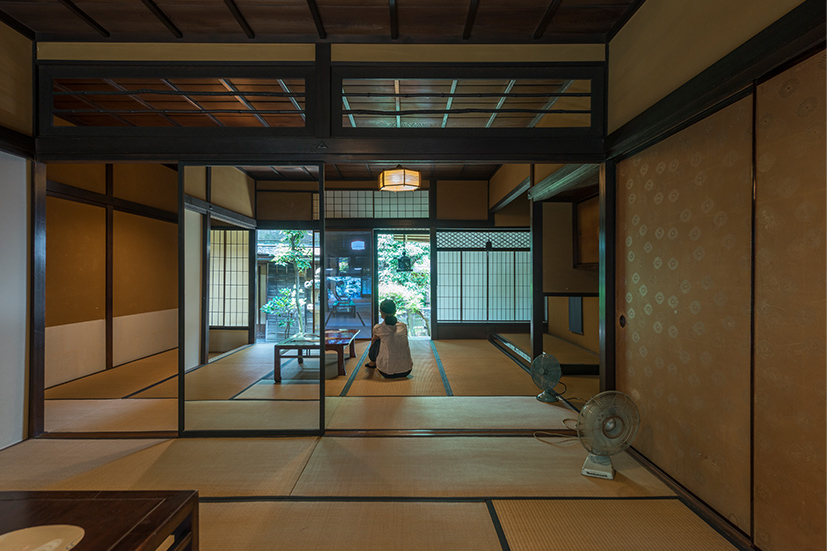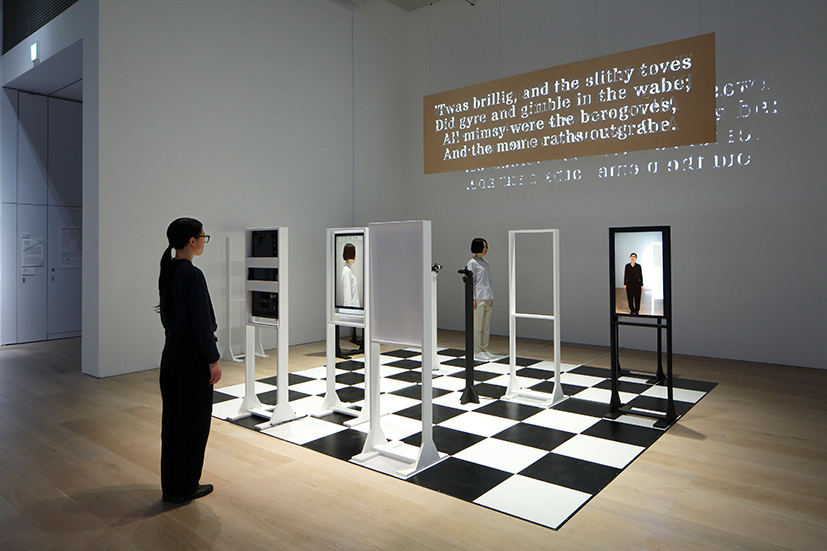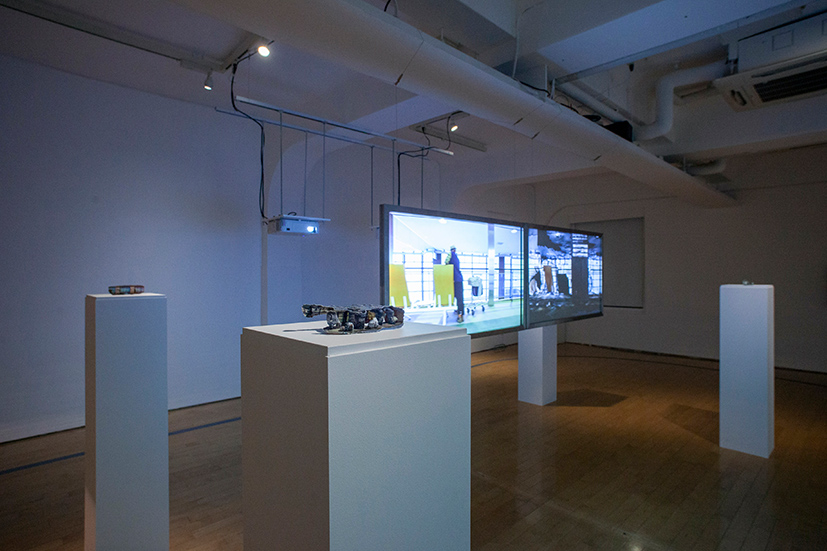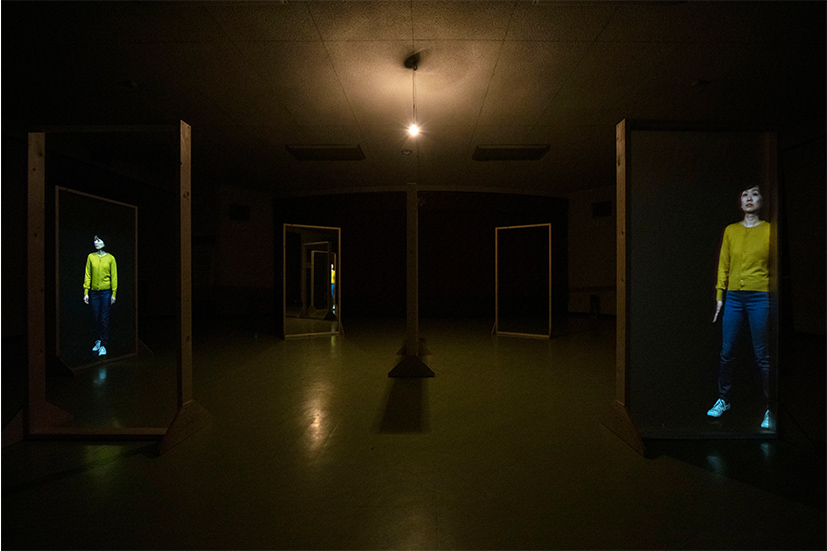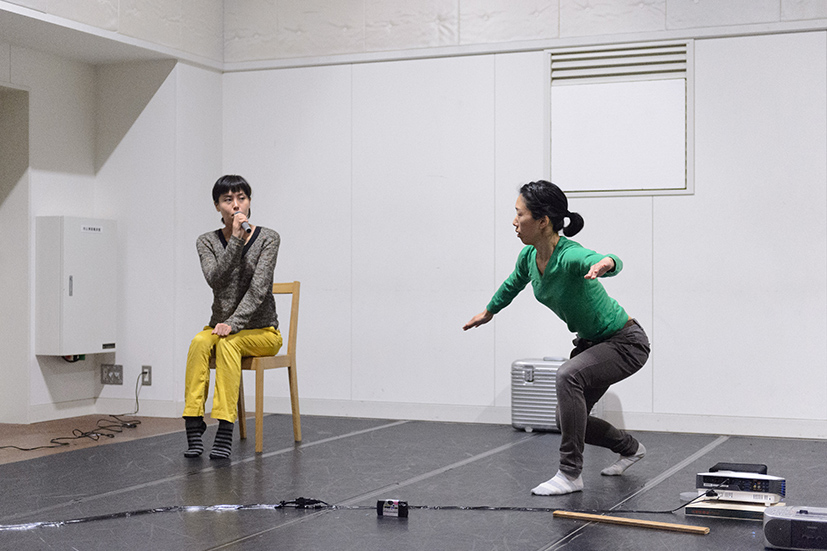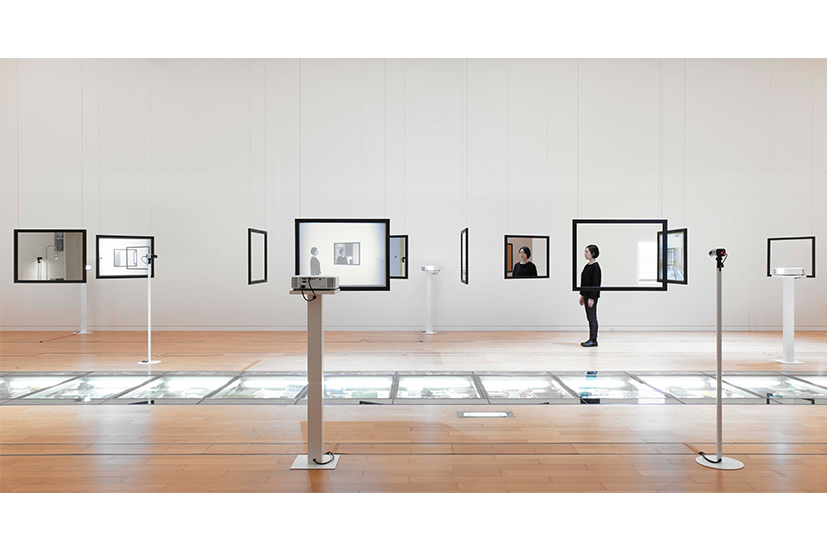Interview with an award winner
TCAA 2022-2024
TSUDA Michiko
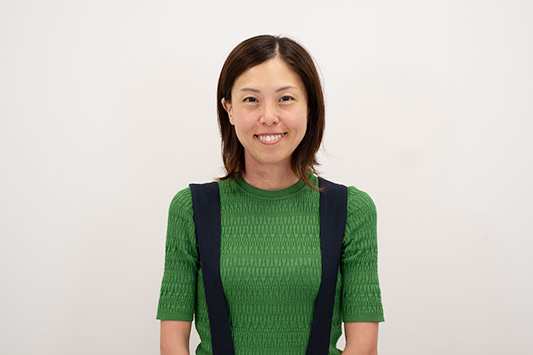
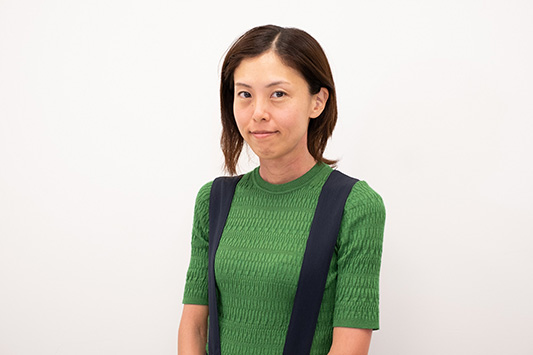
Tsuda Michiko has produced a diverse range of installations and performance pieces, focusing on the characteristics of video media. She creates exhibition spaces where simple structures are arranged and video equipment such as cameras and screens are installed, and visitors who enter the space will encounter an image of themselves captured from an unexpected perspective and time axis. Or, the boundary between the audience and the performer becomes blurred, and you can experience an intermingling of falsity and reality.
Since 2016, as a member of the performance unit “baby tooth,” she has been developing performance works that analyze the movements of characters in Ozu Yasujiro’s films to visualize issues related to distance between people and the roles of women in society.
First of all, could you tell us about this studio visit (held at the Museum of Contemporary Art Tokyo) screening session?
I am currently working on a piece about space and life in the films of Ozu. So, I am living in an old Japanese-style house in Kanazawa as part of the production, so that I can think about how I myself move in this setting. A member of the Selection Committee asked me, “Why do your works involve the works of past masters such as Ozu Yasujiro and Yvonne Rainer?” This is something I had not really thought about, so I was a bit taken aback. I have videos from my childhood that I showed at the TCAA Symposium, but I didn’t show it during the selection presentation, but rather in response to questions. Videos of my family are important to me, but I didn’t use them directly in my work because I thought they would be too mundane to others. I have indirectly dealt with the family scenes, how people conduct themselves, and use of the camera found in Ozu’s works, but in fact, all of that is already in my own family videos. The reason I was doing it in a roundabout way was simply because I didn’t have the courage to do it differently. I’m still thinking about how I’ll do it, but it made me realize that I’m getting more confident and am ready to show it.
Another Selection Committee member asked, “Are you trying to do something about gender roles as a social activity or do you have some personal motivation?” Realizing that my work didn’t convey this, I showed my family video while explaining my perspective.
The unique camerawork in Ozu’s films is a viewpoint that assumes a patriarchal system. Like shooting from the height of a typical low Japanese-style table, with the father at the center of the shot?
That’s what it makes us think, doesn’t it. I wasn’t conscious of the connection between the Showa-era (1926-1989) family scenes shown in the video of my home and scenes in the Ozu’s films. When I showed my video in response to a question after the presentation, then I realized the connection. I had to agree with the comment of a Selection Committee member, who said, “Your work has been produced in an intelligent and analytical manner, but the emotional side isn’t visible.”
Actually, having seen some of your works, I was very curious about that part. For example, while viewing one of your video installations, I felt as if some invisible person could see through my actions and intentions, or that he/she is targeting my blind spot. Your work that was in the “Aichi Triennale 2019: Taming Y/Our Passion,” made a particularly strong impression because the camera and screen were set up in an old Japanese-style house with no clear view of the whole house interior. The atmosphere without any emotion attached is also unique, but how much of that effect is intentional?
We can only objectively see what our body looks like through images, right? I set up a little trick where things are shifted a little and the person who has forgotten about their body image is suddenly confronted with an image that makes them think “Could that be me?” I don’t mean to set a trap to make fun but I aim to create a gap that is fun, just like playing some kind of game. I think that screen images or videos have that kind of element.
Everyone knows they can be made just through structure or they can be made by touching on emotions.
When you are filmed without realizing it, your image appears more objective. That’s just like images taken by surveillance cameras or drive recorders in cars. What are you trying to reveal by this psychological effect?
No one can look at themselves objectively, and although they talk as if they are objective, in reality they are not. But in art, I think it is possible to make discoveries about oneself without any misconceptions.
The structure itself of the installation is quite simple, isn’t it? The specifications may be different, but there were probably people in every era who tried to create something similar as an experimental video. I think there are still many aspects of human blind spots that have yet to be clarified, but what in particular do you want to show?
I believe that small quirks of behavior and the way a person walks can reveal everything about them. There are works that incorporate the unprotected appearance of people just passing by in a place that is not the exhibition space, but there is a point where one step before discovering one’s physical characteristics, one checks whether it is oneself or not, and that is where the true nature of a person spills out. That is a part of the process that can only be captured with a very open mood of appreciation, so I try to think of some game-like trick that makes it feel fun or scary or playful. This is not the case with professional dancers and others who are aware and in control of how they present their bodies.
When and how did you become motivated by the effects of this kind of visual media on people?
When I was in my late twenties, I wanted to create videos and films, and at first I was playing around with smartphones and other devices that were close at hand. Since I was in an environment then that had lighting and other studio facilities, I made a set and began to experiment with the camera and space for several days straight.
I see. With that environment, it seems like a simple theatrical mechanism could be created. In recent years, you have been creating performance works with contemporary dance artists, haven’t you?
It all started when I met Kamimura Megumi , with whom I collaborated on a project in which we took several scenes from Ozu’s films and analyzed, scored, recreated, filmed, and then examined the characters’ movements as a kind of choreography. After that, I interacted with Kamimura-san in the production process of her solo work, and while I was helping her with a creation workshop, before I knew it, I found myself performing in the piece as well. That is how I came to work together with Kamimura-san in the performance unit “baby tooth.”
In addition to Kamimura-san, you are also working with Fukutome Mari in performances. It seems that the themes you are pursuing are closely related to the body, which are issues that these women have been researching for quite a while now too.
Yes, I think that I have been influenced by them. I had just been thinking of a mechanism to connect the inside of the frame and the audience side in my own video, so the process of going out of the video and creating a time line between the audience and the stage side felt right.
In the work discussed earlier, which analyzes the movements of choreographed figures within the camera frame of Ozu’s films, you are trying to make the gender roles visual. The role behavior of men and women seen in the composition of TV dramas depicting life in the Showa-era may be something that generations older than you have simply absorbed unconsciously. However, there are probably differences in how the different generations perceive the roles of men and women.
Even now, when I watch parodied home dramas on TV variety shows, the mother always comes out with tea on a tray. It is the “Sazae-san” (Japan’s ultra-long-running animation show) structure. My generation was also fully experiencing that gender role until we were in our twenties. For people, the family structure is at the base of their consciousness, but I realized that it shouldn’t necessarily have to be this way, and I simply wanted to work on what I had noticed.
When I was staying the US as a part of the Asian Cultural Council (ACC), there was a program in which Japanese films were screened. Obviously there were Ozu’s films. Most of the audience were middle-aged, affluent-looking white American males and I was the sole Asian sitting in the audience watching Tokyo Story. I noticed that the rest of the audience reacted in places different to where a Japanese person would. For example, a woman with a tray silently appears in the screen space and sits in a narrow empty space at the low Japanese-style table. They were very amused just by something like that. This is a scene that perfectly completes the composition of Ozu’s films.
Japanese movies of the Showa-era always revolve around a male-centric point of view, don’t they? It is also standard practice to depict the father’s and daughter’s perspectives as conflicting, but I wonder if the older, wealthy white men can empathize with the actor Ryu Chishu who played the father.
There’s a scene when there’s a conversation on the lines of whether or not the step-daughter is going to remarry. During this sort of scene, the audience all fell silent and watched while meekly expressing their feelings. Watching the film amid this I felt really strange. “Why’s everyone so rigid and tearful?” I wondered. I realized that I felt rather unease about that innocent expression of emotion, and I want to express that in my work as well.
It’s finally getting easier to travel abroad again. Are you thinking of doing any research or production abroad in connection with this award?
I would like to continue my research through my experiences on learning how Japanese culture is viewed in a foreign environment. I also want to resume my research on the New York dance scene and performances of the 1960s and 1970s, such as the Judson Church and Carolee Schneemann. I haven’t had enough time to read the literature, and I feel that I didn’t get a chance to see all of the video materials. I want to continue on with it because I find it to be very inspirational.
What would you like to look further into about performing arts produced at a time when there was a disparity in gender consciousness in the United States?
It feels like it was far more revolutionary than Japan is today. There are still weekly performances at Judson Church, so I am interested to see how much it has changed since performances were first held there. On my previous trip to the States, I had the opportunity to see Yvonne Rainer rehearse and perform and she was doing the same thing as in past material. She’s trying to update it, but I felt a bit relieved after I found out that she is still performing the same things she did in the sixties.
Many of the artists who began working during this period created works as part of the counterculture, motivated by rebellion against politics and social systems, right? Their basic stance hasn’t changed, and they may still think nothing has been resolved.
Yes, I guess that’s why they still keep on doing what they are doing. It still looks fresh to me now, but I would like to continue, as I finished my last research when I started to feel critical of what has not changed. If I were to go, I would go to places like New York or London, where I can see the real thing and access material.
I also want to go see “La Biennale di Venezia” and Documenta. Of course, I would like to see exhibitions of contemporary artists, but I would also like to focus now on those dealing with a time axis.
Is there likely to be an opportunity to create a performance? Maybe as part of a workshop or residency program?
I have not yet decided exactly how I to incorporate my research into a production, but I would like to do a performance if I have the opportunity to do so.
I’d like to know what’s happening now with overseas artists who are engaged in social experimental research through performance expression. In recent years, in Japan, the realms of contemporary dance as a performing art and performance art as a contemporary art have been moving closer together, and the boundary between the two is disappearing. It will be interesting to see how an artist like you, who uses video media, will be involved in this.
Exhibiting is also an experience that I value. How do I feel when I’m going to the exhibition site, and what kind of path have I taken? This is where the experience begins. I would like to create a work that I see as a performance that uses time and the body in total. Even though the work itself was static, I imagine going home and reliving the experience.
The reason that I’m living in an old Japanese-style house is related to that. Although living spaces and exhibition spaces are different, from the perspective of a longer time span, we can say that houses are places where people come and then go, so they share something in common with exhibition spaces. It would be good if I could create a work of art in which the boundary between the two doesn’t exist. I am thinking about using the house I currently live in. I chose this house because it had rooms that could be used as a stage.
Finally, how did you feel about receiving the TCAA Award? Have there been any changes in your life since receiving this award, or any new activities you have started?
There are many awards that support young people and I have benefited from some of them. And I am genuinely grateful for this sort of encouraging support having reached the generation aged 35 or over when support almost instantly evaporates. Winning the award has made me feel that the time has arrive for me to tackle something that I can feel lies at the very core of myself, I want to bring it properly to its conclusion.
In my late thirties, I had a series of big jobs and also side jobs that became more and more important. I also feel that I am more comfortable speaking up than before. I want to establish a strong collaboration with the staff I produce with. I want to make myself stronger and more capable, and create good relationships with others.
Tsuda’s video installations and performances sometimes leave viewers with a feeling that they have some prickle stuck in them that is difficult to get out. If you forget that the art scene is connected to everyday life and let your guard down, feeling protected as a spectator, you will be caught off guard. The viewing experience, guided by an examination of human perception and physical sensation, highlights the gaps in our self-consciousness.
Tsuda’s cool perspective is also relentlessly critical of the gender and structure elements that Japanese people have unconsciously internalized, as in the family scenes in Ozu’s films. Her future research activities abroad will extract the blind spots of contemporary Japan that still stand out among different cultures in an increasingly homogenized global society. Furthermore, her research that traces the trajectory of artists who lived through the turbulent times of the 20th century is sure to bring to light issues faced by people living in a time of pandemics and conflict.
interview, text: SUMIYOSHI Chie
